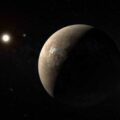Astronomers from the Harvard and Smithsonian Center for Astrophysics have discovered a giant 500 light year “cavity” in our Milky Way, and for the first time, you can use AR (augmented reality) to see it up close by holding it in your hand.
Background: What is A Space “Cavity” And Do They Hurt?
Published in The Astrophysical Journal Letters, the research team believes that the giant void was formed by supernovae that exploded around 10 million years ago. Located between the Perseus and Taurus constellations in the night sky, that region of space is made up of giant molecular clouds and is thought to be a birthplace for stars.
“Hundreds of stars are forming or exist already at the surface of this giant bubble,” study lead Shmuel Bialy, a postdoctoral researcher at the Institute for Theory and Computation at the Center for Astrophysics, said in a press release. “We have two theories—either one supernova went off at the core of this bubble and pushed gas outward forming what we now call the ‘Perseus-Taurus Supershell,’ or a series of supernovae occurring over millions of years created it over time.”
The team’s findings indicate that the Perseus and Taurus molecular clouds may actually be a unified structure and share a common origin- the death of a star.
“This demonstrates that when a star dies, its supernova generates a chain of events that may ultimately lead to the birth of new stars,” Bialy explains.
Analysis: Forget Pictures, I Want My Weird Space Void in 3D
Using the European Space Agency’s Gaia observatory, the space-based system created a 3D map of the void and the surrounding clouds. Previous astronomers knew that these clouds existed, but only in 2D imagery. In three dimensions, the team can see that they are separated and not clumped together. Looking at impressively massive dust clouds, the team realized that they formed a bubble around a giant cavity of empty space. In simple terms, a weird space void.
Space voids are cool and all, but the best part is that scientists and the general public can explore them using AR.
Using a device called a “Merge Cube,” or simply a smartphone, a user can scan the QR code below and run the simulation. You can also find it here.


“You can literally make the universe float over your kitchen table,” says Harvard professor and astronomer Alyssa Goodman, a co-author on the studies and founder of Glue, the software used to create the maps of molecular clouds.
Goodman believes that this type of data visualization will be the “paper of the future” and that interactive maps like this will allow everyone interested in the science to explore it more deeply beyond simple pictures. Moreover, the visual data allows for better investigation and exploration.
Outlook: The Future of Science Papers
“Supernovae are usually thought of as a negative process for cloud formation, with cloud formation being a very energetic phenomenon,” Bialy told Inverse. “Here we have a supernova that is actually helping the formation of clouds…This observation kind of sheds light on the formation process.”
Understanding the mysteries of space is like a puzzle you sometimes have to build in reverse. And it sometimes explodes.
While studying supernovae can shed a lot of light, studying clouds of dust that seem to form around a long-gone star can also answer many questions.
Moreover, as our ability to image deep space objects becomes more elegant, so will our understanding. For now though, you should just float that weird space void over your kitchen table while playing “Drops of Jupiter” by Train in the background.


Follow and connect with MJ Banias on Twitter: @MJBanias
Don’t forget to follow us on Twitter, Facebook, and Instagram, to weigh in and share your thoughts. You can also get all the latest news and exciting feature content from The Debrief on Flipboard, and Pinterest. And subscribe to The Debrief YouTube Channel to check out all of The Debrief’s exciting original shows: DEBRIEFED: Digging Deeper with Cristina Gomez –Rebelliously Curious with Chrissy Newton
